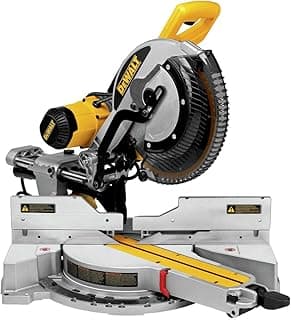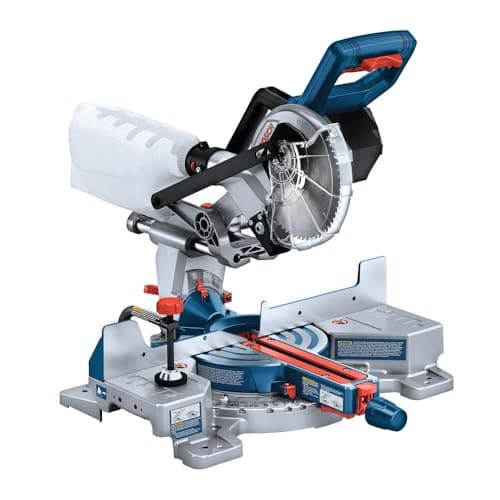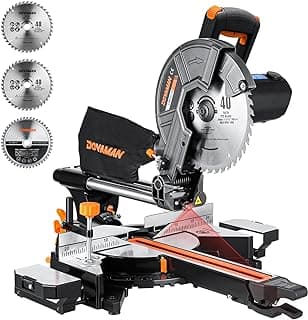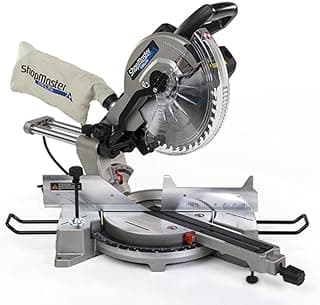When it comes to crown molding, precision is everything. You can’t afford to have uneven cuts or mismatched joints if you want a professional finish. That’s why choosing the best miter saw for crown molding is crucial. But with so many models available, how do you know which one fits your needs?
Let’s dive in. First, consider the best miter saw for trim, which often overlaps with crown molding requirements but focuses on versatility for various trim sizes. Next, think about accessories—like the best miter saw fence system—which can significantly improve support and accuracy when working with large or awkward pieces. Finally, if you have heavy cutting demands, exploring the best chop saw options might be worth your while.
Ready to find the perfect saw? Let’s explore what makes the best miter saw for crown molding stand out and how you can master those tricky angles.
Top Picks
Best Precision: DEWALT Miter Saw, 12 Inch Double Bevel Sliding Compound Miter Saw
The DEWALT 12-inch miter saw stands out for its exceptional precision and durable build. Equipped with a stainless steel miter detent plate featuring 10 positive stops, it ensures accurate and repeatable angle cuts. The cam-lock miter handle with detent override allows users to quickly adjust and lock in precise miter angles. Its tall sliding fences provide strong vertical support for larger workpieces up to 6-3/4 inches. The dual horizontal steel rails combined with linear ball bearings enhance both accuracy and durability, offering smooth and stable blade movement. It bevels left and right from 0 to 48 degrees and supports cross cuts on sizable dimensional lumber, accommodating 2-inch by 14-inch at 90 degrees and 2-inch by 10-inch at 45 degrees.
From a customer perspective, users appreciate the saw’s accuracy and solid construction, which contribute to professional-quality cuts. The precise stops and reliable clamping system make repetitive cuts easier and reduce setup time. However, the corded design can limit portability on job sites without convenient power access, which some buyers note as a drawback compared to cordless alternatives. Overall, it is highly regarded for woodworking projects demanding precision and stability.
Best Versatility: DEWALT 12-Inch Miter Saw, 15-Amp, Single Bevel, Compound (DWS715)
This DEWALT 12-inch miter saw is designed to deliver versatility and precision for woodworking projects. It features a stainless-steel miter detent plate with 14 positive stops, allowing for a broad selection of accurate and repeatable angle cuts. The precise miter system is paired with a machined base fence that offers firm and reliable workpiece support. Its tall sliding fence can support lumber up to 5-1/2 inches vertically, suitable for many common wood sizes. The bevel adjustment ranges widely from 0 to 48 degrees on the left and 0 to 3 degrees on the right, accommodating various angled cuts. Cross-cut capacity includes 2-inch by 8-inch lumber at 90 degrees and 2-inch by 6-inch at 45 degrees, making it suitable for medium-sized wood materials.
Users value the saw’s precision and flexibility, especially appreciating the extra miter stops for detailed angle settings. The tall fence enhances support for taller pieces, which improves cut stability. However, the limited bevel range to the right side is a minor inconvenience for some users needing more flexibility on that side. Overall, the saw is praised for solid performance, reliability, and ease of use in woodworking tasks, though it is best suited for projects within its capacity limits.
Best Compact Precision: DEWALT Miter Saw, Single Bevel, Compound, 10-Inch, 15-Amp (DWS713)
This DEWALT 10-inch miter saw offers precise cutting performance tailored for smaller woodworking projects. It features a stainless-steel miter detent plate with 14 positive stops, providing accurate and repeatable angle settings. The precise miter system, combined with a machined base fence, ensures solid workpiece support and reliable alignment. The tall sliding fence supports lumber up to 4-1/4 inches vertically, which suits moderate-sized materials. The bevel adjustment allows a wide range of 0 to 48 degrees on the left and a narrow 0 to 3 degrees on the right. Its cross-cut capacity accommodates 2-inch by 6-inch lumber at 90 degrees and 2-inch by 4-inch lumber at 45 degrees, ideal for compact or finish work.
Users appreciate the saw’s compact size and accuracy, especially for detailed cuts in trim or small framing tasks. The 14 positive stops enable efficient repetitive cutting without constant recalibration. However, the limited cross-cut capacity restricts its use on larger or thicker materials. Overall, it is well-regarded as a precise and reliable saw for light to medium-duty woodworking with space or portability considerations.
FAQs
What is the best miter saw for crown molding?
The best miter saw for crown molding combines precision, ease of adjustment, and versatility. Sliding compound miter saws are typically the top choice because they allow for wide cuts and compound angles needed for crown molding. Look for features like:
-
High bevel range: Essential for cutting compound angles up to 45 degrees or more.
-
Accurate miter detents: Helps lock the saw at common angles.
-
Laser guides or LED lights: For precise cut line visibility.
-
Sliding rails: Increase cutting capacity for wider crown molding.
-
Sturdy fence system: Supports the molding during cuts to prevent movement.
Popular models from brands like DeWalt, Makita, and Bosch are often recommended for their balance of power, accuracy, and durability.
What kind of saw is best for crown molding?
A sliding compound miter saw is generally the best type for crown molding because it can tilt and pivot to accommodate the angled cuts that crown molding requires. Unlike basic miter saws, sliding models extend their blades forward and backward, allowing longer boards to be cut cleanly.
If your crown molding pieces are smaller or you have limited space, a non-sliding compound miter saw can also work but with size limitations. Radial arm saws and chop saws are less ideal because they don’t provide the compound bevel capabilities needed for precise crown molding cuts.
Can I cut crown molding with a miter saw?
Yes, you can—and should—cut crown molding with a miter saw. This tool is specifically designed for making the precise angled cuts crown molding demands. To cut crown molding properly, it should be placed against the saw’s fence at the correct spring angle (usually 38 or 45 degrees, depending on the molding profile).
Many professionals also recommend using a crown molding jig or properly positioning the molding on the saw (either nested flat or upside down) to ensure accuracy. The miter saw’s adjustable bevel and miter settings allow for perfect inside and outside corners, creating tight, professional joints.
What angle to cut 45 degree crown molding?
For a 45-degree crown molding installation, you will typically set your miter saw to cut at 45 degrees on the miter scale, but the bevel angle depends on the molding’s spring angle and the installation method.
Commonly, a compound miter saw cut involves:
-
Miter angle: Usually set at 31.6 degrees for a standard 38-degree spring angle molding or adjusted to 45 degrees for certain profiles.
-
Bevel angle: Set at 33.9 degrees or zero degrees, depending on the cutting position and molding orientation.
Since crown molding sits at an angle on the wall, the saw blade must be tilted and rotated correctly to cut the profile’s spring angle. The precise angles vary based on molding design and the corner type (inside or outside). Using an adjustable saw and consulting an angle chart or digital angle finder helps achieve perfect cuts.
Final Thoughts
Choosing the best miter saw for crown molding means investing in a tool that delivers accuracy, versatility, and durability. Sliding compound miter saws stand out as the most capable, offering the essential features needed to handle intricate angles and large molding pieces. By pairing your saw with quality accessories like a reliable miter saw fence system and understanding the correct cutting angles, you’ll achieve professional results every time. Whether upgrading your workshop or starting a new project, the right miter saw makes all the difference in crafting flawless crown molding finishes.






















